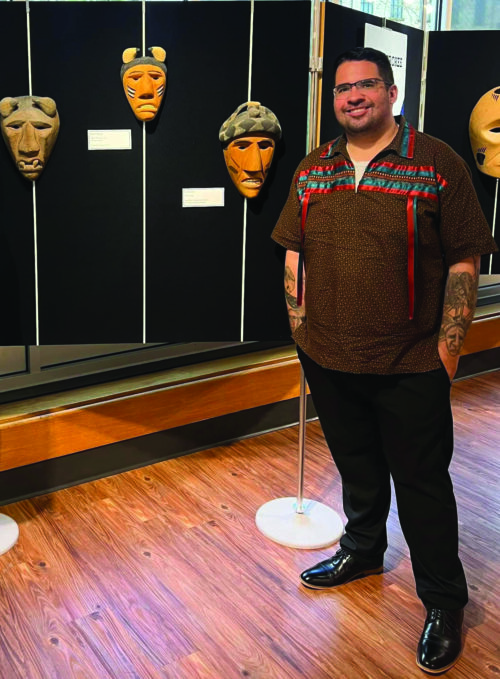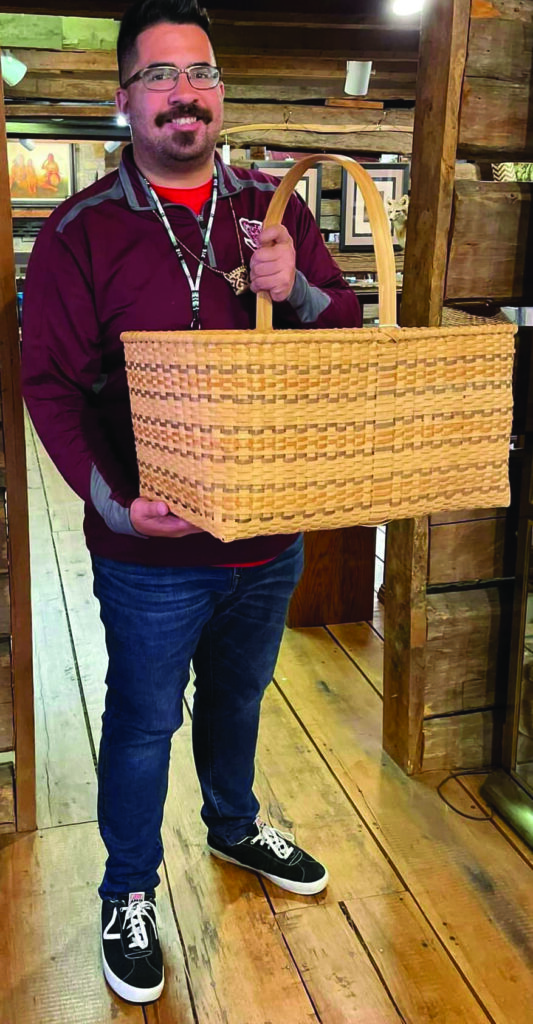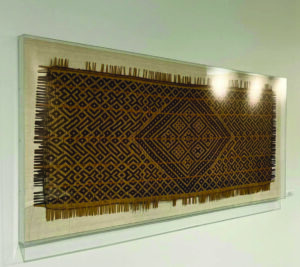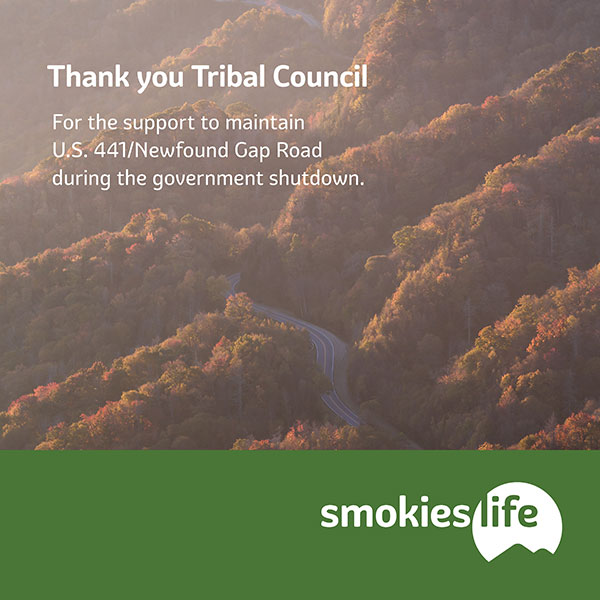By BROOKLYN BROWN
One Feather Reporter
CHEROKEE, N.C. – Driver Blythe, a member of the Eastern Band of Cherokee Indians (EBCI), is a graduate student and student teacher in Western Carolina University’s Cherokee Studies program. As an apprentice of the late and renowned art collector Lambert Wilson who boasted an enormous collection of Cherokee art, Blythe is carving his own path as a Cherokee art collector.

Driver Blythe is shown with three generations of masks made by Will West Long, Allen Long, and Will Long. (Photos contributed)
Blythe became interested in learning about Cherokee art history after seeing and purchasing a fish basket from Cherokee basket maker Ramona Lossie and conversing with Lossie about the intimate process of Cherokee basket making.
“I wanted to learn about my culture’s art and collect the best art there was by the best artists who ever did it. I learned quickly that art by John Julius Wilnoty, Eva Wolfe, Maude Welch, and other greats wasn’t just readily available and that it was going to be a lot more difficult to find the phenomenal work I sought after,” Blythe said.
Blythe’s mother and aunt pointed him in the direction of Lambert Wilson.
“They told me there was a gentleman by the name of Lambert Wilson who happened to have a top tier collection of Cherokee art. When I met Lambert at his house, I realized that ‘top tier’ was an understatement. Lambert showed me the finest stone carvings, double weave baskets, and pottery pieces that hadn’t ever been duplicated.”
Through two years of mentorship with Wilson, Blythe said he learned, “…the value in Cherokee art, the rarity of our art, and the decades of change,” that would mark the different eras of carving, basketry, pottery, and other mediums.
Blythe collects many forms of Cherokee art, but has a particular eye for rivercane baskets, Cherokee masks, and other carvings. “Being the great grandson of a mask maker, I feel that’s why I have a natural liking for them. I have managed to obtain masks by Sim Jessan, Will West Long, Allen Long, Davy Arch, June Welch and so many others, and this has been mostly by luck, patience, and perseverance.”

Driver Blythe is shown holding a basket made by Eva Reed.
Blythe’s appreciation for Cherokee basketry developed from the work of two artists in particular, “I fell in love with the work of Eva Wolfe’s basketry and Edmund Youngbird’s basketry. It was from there that I grew to appreciate the different styles each artist possessed and started to learn their techniques, finishes, dyes, and weaving styles,” Blythe said.
“That’s not to say I can identify any basket that has ever been made, but when you study the major names in not just basketry, but carvings, pottery, and other mediums, it becomes a lot easier to know what you’re looking for and the value it brings.”
Blythe says that although his practice is called “art” collection, he doesn’t really view it that way, because of a conversation he had with the late JC Wachacha and Tom Belt. “They told me there wasn’t a Cherokee word, necessarily, for art. It was more of a ‘use’ and ‘making it into something else,’ which confused me at first,” he said.
“They explained that traditionally the Creator made everything. The world is His art. The world the Creator made is the ‘art.’ When we take a piece of wood from a tree, or a rivercane bundle out of a patch, or even clay from the Earth, we are making it into ‘use’ or ‘something else.’”
Blythe said he knows this is a philosophy up for discussion in the art world, but it is the philosophy he has adopted to approach collection. “Our masks, our baskets, our carvings, our pottery, or beadwork, and all of our mediums, serve a purpose, and that is how the artists who have passed on guide us today.”

A rivercane mat made by Edmund Youngbird.
For Blythe, many of those artists come from the mid-to-late twentieth century, which he calls a “booming period” for Cherokee art. “I don’t like when people say, ‘Gone are the days of great Cherokee art,’ I just feel it’s evolved into a different time. But I will say, there are just some greats like John Julius Wilnoty, Shan Goshorn, Virgil Ledford and others who will forever and always just stand the test of time as being all-time greats,”
“The 1960s-1990s witnessed some of the most extravagant pieces of art known not just to Cherokee, but the world. We witness baskets from Eva Wolfe that set record-breaking auction records for Native American baskets as a whole. We also see Goingback Chiltoskey and Amanda Crowe carvings that become the center point of auction houses, and the names of these artists continue to inspire and garner acclaim even decades after their passing.”
Through Blythe’s collection work, he’s become hopeful for the future of traditional Cherokee art and art making. “I love the art that is coming out today. I’m happy to say that some of my dearest friends are phenomenal artists and are bringing a major name to their art. I am happy to say I have work by Selena Torres, Dewey Owle, Davy Arch and others. It’s all phenomenal stuff that artists my age and younger are making.”
As an art collector, Blythe says there is an element of Cherokee art collection that cannot be replicated, and that is the bond between Cherokee art and Cherokee artist.
“The intimate and cultural bond they have with their craftsmanship is beautiful to hear when you listen to old recordings of why they continue to do the rigorous crafts when they’re even in their 90s. As fluent speaker and master wood carver Davis Welch once told me, “It’s hard to explain in English what goes into their craft…it’s best said in Cherokee.”




